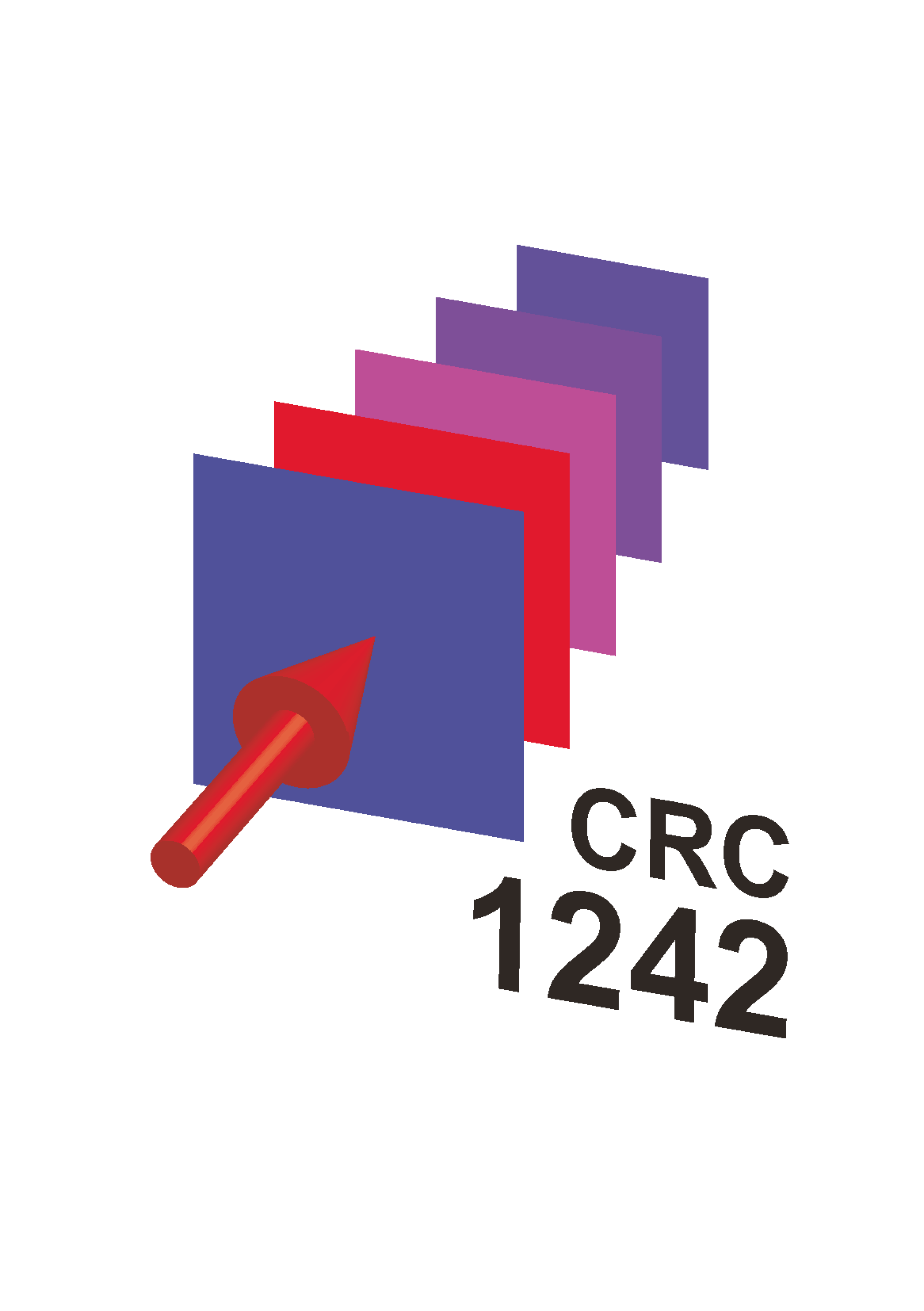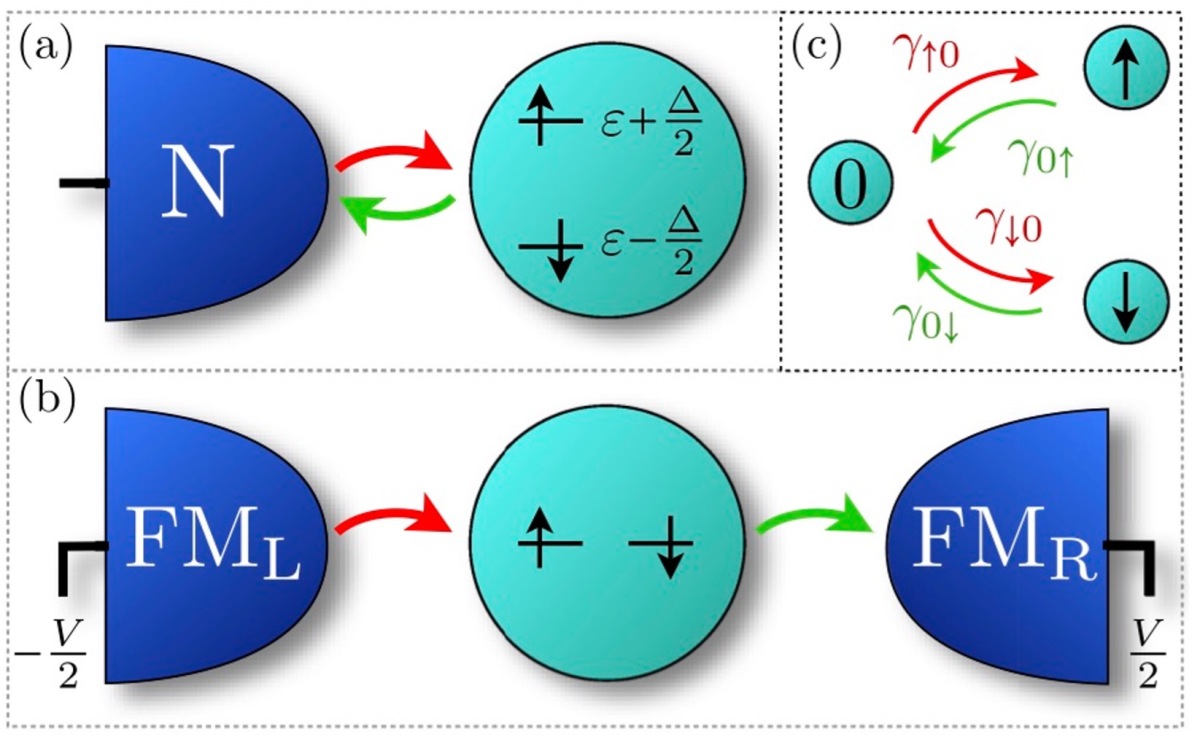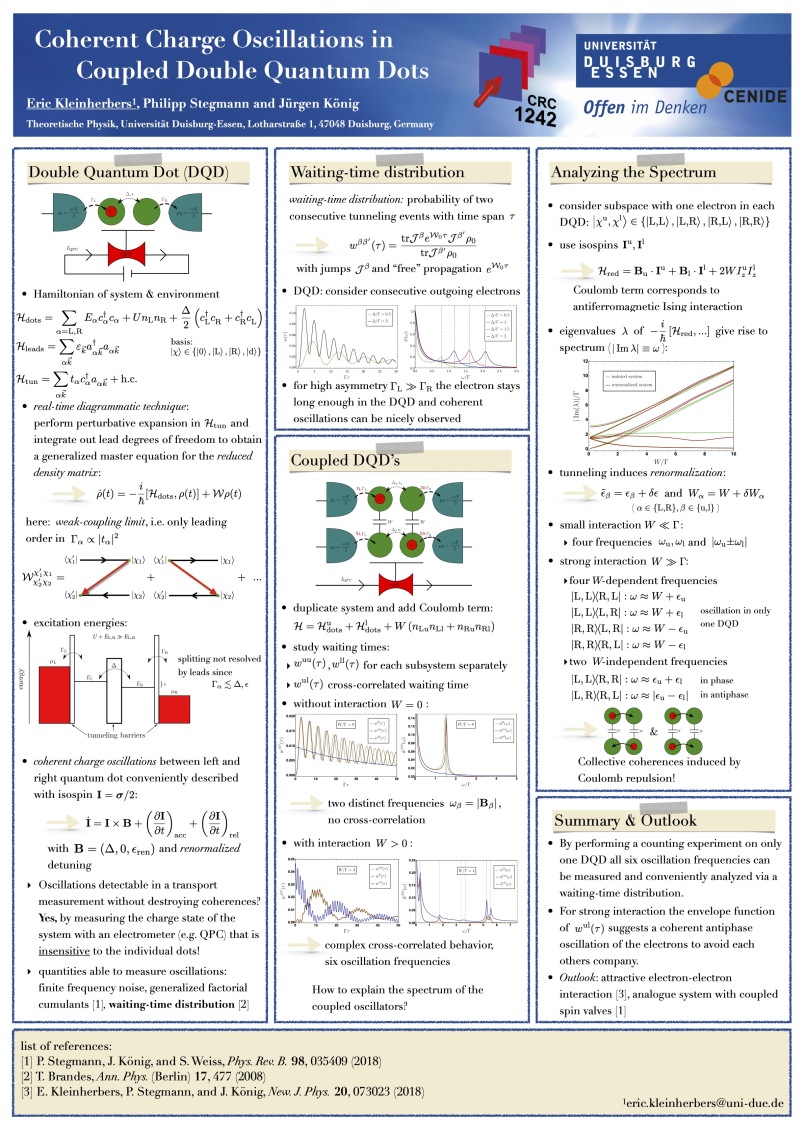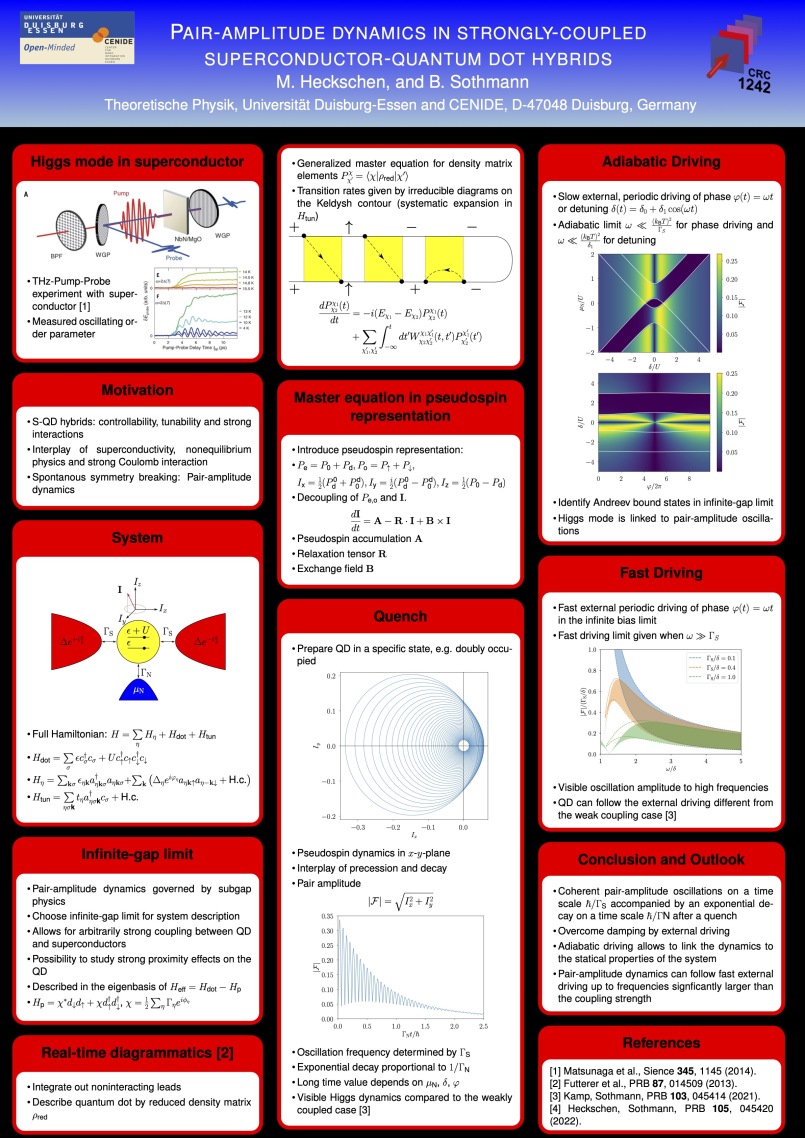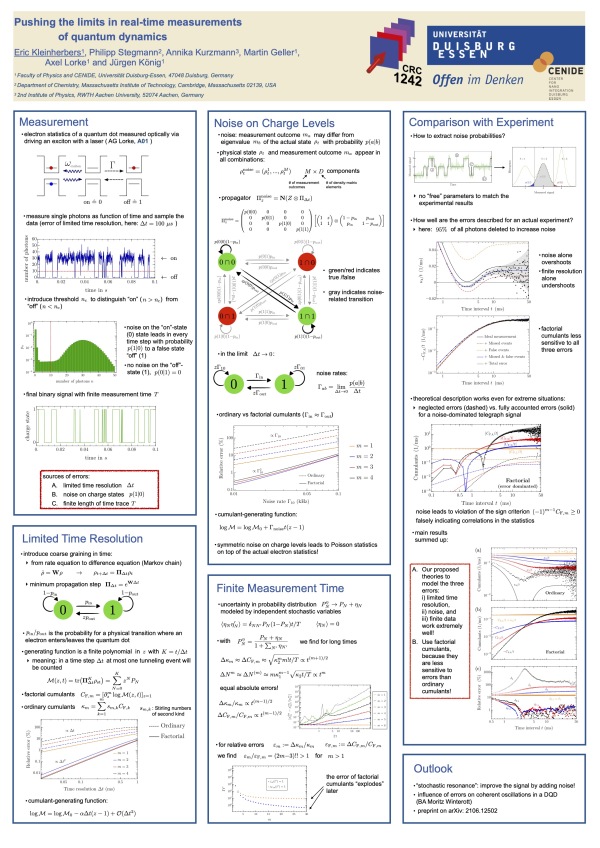Overview of project A02
Charge Carrier Dynamics in Nanostructures
This project aims at the theoretical description of the dynamics of single electrons in nanodevices in the time domain. The focus on single electrons defines the ultimate conceivable resolution for charge carrier dynamics, provides a convenient platform to study fundamental relaxation processes, and may become relevant for single-electron applications. Nanodevices such as quantum dots are well suited for studying charge carrier dynamics in this ultimate limit since they allow one to address individual electrons, to isolate them from the outside world, to manipulate them in a controlled way by gate voltages, and to study interesting correlations due to Coulomb interaction. The time domain of the charge carrier dynamics can be accessed by making use of external stimuli such as gate pulses. An alternative approach is based on analyzing the full counting statistics of individual charge-transfer events since the full counting statistics provides the maximum information of a dynamic quantum system. The theoretical challenge is, then, to distill out of this full counting statistics the relevant information about the charge dynamics to gain insight into relaxation channels, coherent quantum oscillations, or nonequilibrium many-body states evoked by interaction-induced correlations.
Figure: The charge dynamics in a single-level quantum dot tunnel coupled to one or several electron reservoirs and with large charging energy can be modelled by a three-state system.
Publications
2025
Gernot Schaller, Friedemann Queisser, S.P. Katoorani, Christian Brand, Christian Kohlfürst, Mark R. Freeman, Alfred Hucht, Peter Kratzer, Björn Sothmann, Michael Horn-von Hoegen and Ralf Schützhold
Kibble-Zurek Dynamics in the Anisotropic Ising Model of the Si(001) Surface
Phys. Rev. Lett. 134, 246202 (2025)
DOI: 10.1103/rmc4-xqb3
Nico F. Brosda, Phil J. Badura, İsmail Bölükbaşı, İbrahim Engin, Patrick Lindner, Sascha R. Valentin, Andreas D. Wieck, Björn Sothmann and Arne Ludwig
Towards Quantitative Understanding of Quantum Dot Ensemble Capacitance-Voltage Spectroscopy
Phys. Rev. B 112, 165201 (2025)
DOI: 10.1103/pz15-3f87
Hendrik Mannel, Johann Zöllner, Eric Kleinherbers, Marcel Zöllner, N. Schwarz, F. Rimek, A. D. Wieck, A. Ludwig, Axel Lorke, Jürgen König and Martin Geller
Quantum Stochastic Resonance in a Single-Photon Emitter
Commun. Phys. 8, 404 (2025)
DOI: 10.1038/s42005-025-02334-4
Jonas Fußangel, Björn Sothmann, Sven Johannsen, Sascha Ossinger, Felix Tuczek, Richard Berndt, Jürgen König and Manuel Gruber
Statistical Analysis of Electron-Induced Switching of a Spin-Crossover Complex
Phys. Rev. B 112, 235426 (2025)
DOI: 10.1103/bkxj-2gvp
2024
Christian Brand, Alfred Hucht, Hamid Mehdipour, Giriraj Jnawali, Jonas D. Fortmann, Mohammad Tajik, Rüdiger Hild, Björn Sothmann, Peter Kratzer, Ralf Schützhold and Michael Horn-von Hoegen
Critical Behavior of the Dimerized Si(001) Surface: Continuous Order-Disorder Phase Transition in the Two-Dimensional Ising Universality Class
Phys. Rev. B 109, 134104 (2024)
DOI: 10.1103/PhysRevB.109.134104
Tobias Kuhn, Björn Sothmann and Jorge Cayao
Floquet Engineering Higgs Dynamics in Time-Periodic Superconductors
Phys. Rev. B 109, 134517 (2024)
DOI: 10.1103/PhysRevB.109.134517
Alessandro Braggio, Matteo Carrega, Björn Sothmann and Rafael Sánchez
Nonlocal Thermoelectric Detection of Interaction and Correlations in Edge States
Phys. Rev. Res. 6, L012049 (2024)
DOI: 10.1103/PhysRevResearch.6.L012049
Johann Zöllner, Philipp Stegmann, Jürgen König and Eric Kleinherbers
Dark Versus Blocking States in Electronic Transport: A Lee-Yang Zero Analysis of Full Counting Statistics
Phys. Rev. B 110, 115411 (2024)
DOI: 10.1103/PhysRevB.110.115411
2023
Yazin Beyazit, Florian Kühne, Detlef Diesing, Ping Zhou, Jesumony Jayabalan, Björn Sothmann and Uwe Bovensiepen
Ultrafast Electron Dynamics in Au/Fe/MgO(001) Analyzed by Au- and Fe-Selective Pumping in Time-Resolved Two-Photon Photoemission Spectroscopy: Separation of Excitations in Adjacent Metallic Layers
Phys. Rev. B 107, 085412 (2023)
DOI: 10.1103/PhysRevB.107.085412
Jens Kerski, Hendrik Mannel, Pia Lochner, Eric Kleinherbers, Annika Kurzmann, Arne Ludwig, Andreas Wieck, Jürgen König, Axel Lorke and Martin Geller
Post-Processing of Real-Time Quantum Event Measurements for an Optimal Bandwidth
Sci. Rep. 13, 1105 (2023)
DOI: 10.1038/s41598-023-28273-0
Christian Brand, Alfred Hucht, Giriraj Jnawali, Jonas D. Fortmann, Björn Sothmann, Hamid Mehdipour, Peter Kratzer, Ralf Schützhold and Michael Horn-von Hoegen
Dimer Coupling Energies of the Si(001) Surface
Phys. Rev. Lett. 130, 126203 (2023)
DOI: 10.1103/PhysRevLett.130.126203
Eric Kleinherbers, Alexander Schünemann and Jürgen König
Full Counting Statistics in a Majorana Single-Charge Transistor
Phys. Rev. B 107, 195407 (2023)
DOI: 10.1103/PhysRevB.107.195407
Claire Besson, Philipp Stegmann, Michael Schnee, Zeila Zanolli, Simona Achilli, Nils Wittemeier, Asmus Vierck, Robert Frielinghaus, Paul Kögerler, Janina Maultzsch, Pablo Ordejón, Claus M. Schneider, Alfred Hucht, Jürgen König and Carola Meyer
Independent and Coherent Transitions Between Antiferromagnetic States of Few-Molecule Systems
Phys. Rev. B 107, 245414 (2023)
DOI: 10.1103/PhysRevB.107.245414
Eric Kleinherbers, Hendrik Mannel, Jens Kerski, Martin Paul Geller, Axel Lorke and Jürgen König
Unraveling Spin Dynamics from Charge Fluctuations
Phys. Rev. Research 5, 043103 (2023)
DOI: 10.1103/PhysRevResearch.5.043103
Markus Heckschen, Yasin Beyazit, Elaheh Shomali, Florian Kühne, Jesumony Jayabalan, Ping Zhou, Detlef Diesing, Markus E. Gruner, Rossitza Pentcheva, Axel Lorke, Björn Sothmann and Uwe Bovensiepen
Spatio-Temporal Electron Propagation Dynamics in Au/Fe/MgO(001) in Nonequilibrium: Revealing Single Scattering Events and the Ballistic Limit
PRX Energy 2, 043009 (2023)
DOI: 10.1103/PRXEnergy.2.043009
2022
Markus Heckschen and Björn Sothmann
Pair-Amplitude Dynamics in Strongly Coupled Superconductor–Quantum Dot Hybrids
Phys. Rev. B 105, 045420 (2022)
DOI: 10.1103/PhysRevB.105.045420
Eric Kleinherbers, Philipp Stegmann, Annika Kurzmann, Martin Paul Geller, Axel Lorke and Jürgen König
Pushing the Limits in Real-Time Measurements of Quantum Dynamics
Phys. Rev. Lett. 128, 087701 (2022)
DOI: 10.1103/PhysRevLett.128.087701
Naser Ahmadiniaz, Martin Paul Geller, Jürgen König, Peter Kratzer, Axel Lorke, Gernot Schaller and R. Schützhold
Quantum Zeno Manipulation of Quantum Dots
Phys. Rev. Research 4, L032045 (2022)
DOI: 10.1103/PhysRevResearch.4.L032045
Florian Kühne, Yasin Beyazit, Björn Sothmann, Jesumony Jayabalan, Detlef Diesing, Ping Zhou and Uwe Bovensiepen
Ultrafast Transport and Energy Relaxation of Hot Electrons in Au/Fe/MgO(001) Heterostructures Analyzed by Linear Time-Resolved Photoelectron Spectroscopy
Phys. Rev. Res. 4, 033239 (2022)
DOI: 10.1103/PhysRevResearch.4.033239
Simon Mundinar, Alexander Hahn, Jürgen König and Alfred Hucht
Transfer-Matrix Summation of Path Integrals for Transport Through Nanostructures
Phys. Rev. B 106, 165427 (2022)
DOI: 10.1103/PhysRevB.106.165427
2021
Eric Kleinherbers, Philipp Stegmann and Jürgen König
Synchronized Coherent Charge Oscillations in Coupled Double Quantum Dots
Phys. Rev. B 104, 165304 (2021)
DOI: 10.1103/PhysRevB.104.165304
Mathias Kamp and Björn Sothmann
Higgs-Like Pair Amplitude Dynamics in Superconductor–Quantum-Dot Hybrids
Phys. Rev. B 103, 045414 (2021)
DOI: 10.1103/PhysRevB.103.045414
Jürgen König and Alfred Hucht
Newton Series Expansion of Bosonic Operator Functions
SciPost Physics 10, 007 (2021)
DOI: 10.21468/SciPostPhys.10.1.007
Philipp Stegmann, Björn Sothmann, Jürgen König and Christian Flindt
Electron Waiting Times in a Strongly Interacting Quantum Dot: Interaction Effects and Higher-Order Tunneling Processes
Phys. Rev. Letters 127, 096803 (2021)
DOI: 10.1103/PhysRevLett.127.096803
Philipp Stegmann, Alex Gee, Neil T. Kemp and Jürgen König
Statistical Analysis of Spin Switching in Coupled Spin-Crossover Molecules
Phys. Rev. B 104, 125431 (2021)
DOI: 10.1103/PhysRevB.104.125431
2020
Simon Mundinar, Alfred Hucht, Jürgen König and Stephan Weiß
Interaction-Induced Current Asymmetries in Resonant Transport through Interacting Quantum-Dot Spin Valves Revealed by Iterative Summation of Path Integrals
Phys. Rev. B 102, 045404 (2020)
DOI: 10.1103/PhysRevB.102.045404
Philipp Stegmann, Jürgen König and Björn Sothmann
Relaxation Dynamics in Double-Spin Systems
Phys. Rev. B 101, 075411 (2020)
DOI: 10.1103/PhysRevB.101.075411
Martin Maurer, Jürgen König and Herbert Schoeller
Multilevel Coherences in Quantum Dots
Phys. Rev. Research 2, 033440 (2020)
DOI: 10.1103/PhysRevResearch.2.033440
2019
Simon Mundinar, Philipp Stegmann, Jürgen König and Stephan Weiß
Iterative Path-Integral Summations for the Tunneling Magnetoresistance in Interacting Quantum-Dot Spin Valves
Phys. Rev. B 99, 195457 (2019)
DOI: 10.1103/PhysRevB.99.195457
Annika Kurzmann, Philipp Stegmann, Jens Kerski, R. Schott, A. Ludwig, A. D. Wieck, Jürgen König, Axel Lorke and Martin Geller
Optical Detection of Single-Electron Tunneling into a Semiconductor Quantum Dot
Phys. Rev. Lett. 122, 247403 (2019)
DOI: 10.1103/PhysRevLett.122.247403
2018
Philipp Stegmann, Jürgen König and Stephan Weiß
Coherent Dynamics in Stochastic Systems Revealed by Full Counting Statistics
Phys. Rev. B 98, 035409 (2018)
DOI: 10.1103/PhysRevB.98.035409
Eric Kleinherbers, Philipp Stegmann and Jürgen König
Revealing Attractive Electron-Electron Interaction in a Quantum Dot by Full Counting Statistics
New J. Phys. 20, 073023 (2018)
DOI: 10.1088/1367-2630/aad14a
2017
Philipp Stegmann and Jürgen König
Violation of Detailed Balance for Charge-Transfer Statistics in Coulomb-Blockade Systems
phys. stat. sol. (B) 254, 1600507 (2017)
DOI: 10.1002/pssb.201600507
Philipp Stegmann and Jürgen König
Inverse Counting Statistics Based on Generalized Factorial Cumulants
New J. Phys. 19, 023018 (2017)
DOI: 10.1088/1367-2630/aa5a70

